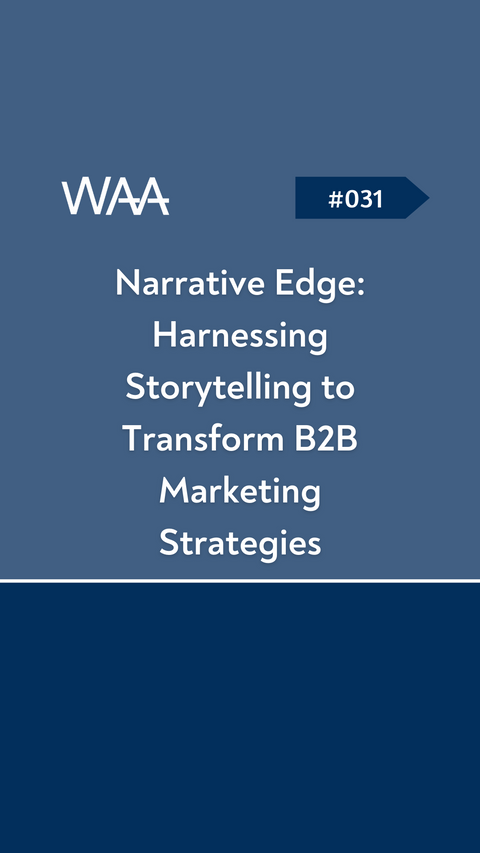
#031 Narrative Edge: Harnessing Storytelling to Transform B2B Marketing Strategies
Storytelling in B2B Marketing: The Untapped Potential
When we think of storytelling, we often associate it with consumer brands and their ability to captivate audiences through emotional narratives. However, storytelling is not limited to B2C marketing. In fact, it has untapped potential for B2B marketing as well. In this blog, we will explore the power of storytelling in B2B marketing and discuss how to leverage this strategy to create meaningful connections, build trust, and drive success.
The Importance of Storytelling in B2B Marketing
In the world of B2B marketing, where brands are often seen as rational and logical, incorporating storytelling can help businesses stand out from the competition. Stories have a unique ability to engage and resonate with audiences, making them more memorable and relatable. By leveraging storytelling, B2B brands can reap the following benefits:
1. Captivating the Audience: Stories have the power to capture attention and ignite emotions. By telling stories, B2B brands can create an emotional connection with their target audience, engaging them on a deeper level and fostering a sense of connection and empathy. A compelling story can make your brand more memorable and relatable.
2. Communicating Complex Ideas: B2B marketing often involves complex products or services. Communicating these ideas in a clear and understandable manner can be a challenge. However, stories provide a way to simplify and communicate complex ideas in a relatable and easily understandable manner. By framing the product or service within a narrative, businesses can make it more accessible and appealing to their audience.
3. Building Trust and Credibility: Trust is crucial in B2B relationships. Storytelling allows B2B brands to humanize their message, making them more approachable and trustworthy. When businesses share compelling stories of challenges overcome, successes achieved, and lessons learned, they demonstrate their expertise and create a sense of reliability and credibility.
4. Creating Brand Differentiation: In a crowded marketplace, differentiation is key. Storytelling provides an opportunity for B2B brands to differentiate themselves by showcasing their unique value, company culture, and brand identity. Through stories, businesses can highlight their mission, values, and the impact they have on their customers and the industry. This helps create a strong and distinct brand image.
How to Incorporate Storytelling in B2B Marketing
Now that we understand the importance of storytelling in B2B marketing, let's explore how to incorporate it into your strategy effectively. Here are some tips to help you leverage storytelling in your B2B marketing efforts:
1. Define Your Brand Story: Start by defining your brand story. What is your mission? What values do you stand for? What is the story behind your brand's inception? Develop a narrative that aligns with your brand identity and resonates with your target audience. This foundational story will serve as the backbone for all your future storytelling efforts.
2. Understand Your Audience: To craft impactful stories, you need to understand your audience's pain points, desires, and motivations. Conduct market research, engage with your target customers, and listen to their stories. This will help you create narratives that speak directly to their needs and aspirations. Understanding your audience is crucial for creating stories that resonate.
3. Present your Customers as Heroes: Showcase your customers as the heroes in your stories. Demonstrate how your products or services have helped them overcome challenges, achieve success, or transform their business. This not only creates a sense of credibility but also allows potential customers to see themselves in the narrative. By highlighting the success of your customers, you can showcase the value you bring to the table.
4. Incorporate Real-Life Examples: Sharing real-life examples and case studies can support your storytelling efforts. Highlight specific instances where your product or service made a difference for a customer. This adds authenticity and credibility to your brand's storytelling. Real-life examples provide concrete evidence of the value you deliver.
5. Utilize Visuals: Visuals help bring your stories to life, making them more impactful and memorable. Incorporate visuals such as images, videos, infographics, and animations to complement and enhance your narratives. Visuals can effectively convey emotions, showcase your product or service, and create a more immersive storytelling experience. They can make your stories more engaging and compelling.
6. Leverage Different Channels: Utilize various marketing channels to present and amplify your stories. This includes your website, social media platforms, blog posts, email newsletters, and even events. Consistency across channels is key to ensure your audience receives a cohesive and engaging storytelling experience. Consider where your target audience spends their time and tailor your storytelling efforts accordingly.
Creating Storytelling-Driven Branding Strategies
Storytelling is not just a one-time effort; it should be woven into the fabric of your overall branding strategy. Here are a few tips to create storytelling-driven branding strategies:
1. Create a Content Marketing Plan: Develop a content marketing plan that prioritizes storytelling. Identify the key themes, topics, and narratives that align with your brand story and will resonate with your target audience. Craft blog posts, articles, videos, and other content formats that consistently incorporate storytelling elements. Use storytelling to guide your content strategy.
2. Engage with Your Audience: Actively engage with your audience through social media, comments sections on your website, and other channels. Encourage them to share their stories and experiences related to your brand. Respond to their comments and feedback, using storytelling to strengthen the connection with your audience. Engaging with your audience creates a sense of community.
3. Collaborate with Customers: Partner with your customers to co-create content and tell their stories alongside yours. This can include written case studies, video testimonials, or joint speaking opportunities at conferences. Collaborating with customers not only strengthens relationships but also expands your storytelling potential. It shows that you value your customers and their experiences.
4. Train Your Sales Team: Train your sales team to incorporate storytelling in their sales pitches and presentations. Equip them with the narratives, examples, and visuals that effectively communicate your brand's value proposition and resonate with potential customers. This will help create a consistent storytelling experience throughout the customer journey. Sales teams can be powerful storytellers.
5. Track and Measure: Establish key performance indicators (KPIs) to track the effectiveness of your storytelling efforts. Monitor metrics such as engagement, brand sentiment, website traffic, and conversion rates to determine the impact of storytelling on your overall marketing strategy. Use these insights to refine your storytelling approach over time. Track the impact of your storytelling efforts.
The Power of Stories in B2B Marketing
In the realm of B2B marketing, storytelling has the potential to unlock new opportunities, build stronger relationships, and differentiate your brand from the competition. By captivating your audience, communicating complex ideas effectively, and building trust and credibility, storytelling can contribute to long-term success. Incorporate storytelling into your B2B marketing strategy, and harness its power to create meaningful connections, elevate your brand, and drive business growth. Take action and discover the impact of storytelling on your B2B marketing endeavors.
